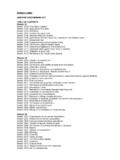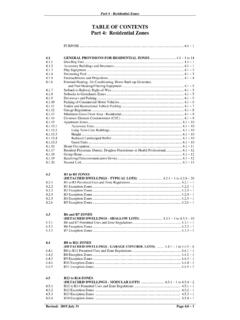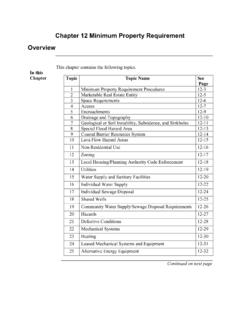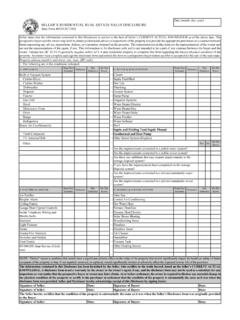Transcription of National Construction Code 2016 - Part 3.7.1 - Fire ...
1 PART FIRE SAFETY. Fire Separation Smoke Alarms Heating Appliances Bushfire Areas Alpine Areas NCC 2016 Building Code of Australia - Volume Two Page 247. PART CONTENTS. PART FIRE SAFETY. Fire separation Application 3. 7 . General concession - non-combustible materials 3. External walls of Class 1 buildings Measurement of distances 3. Construction of external walls 3. 7. Class 10a buildings Allowable encroachments Separating walls 3. Fire hazard properties . Roof lights . Separating floors Smoke alarms 3. 7 . Application Requirements for smoke alarms Location - Class 1a buildings Location - Class 1b buildings 3. Lighting to assist evacuation - Class 1b buildings Heating appliances Acceptable Construction manuals 3. 7. Application 3. Open fireplace Construction Chimney Construction 3.
2 Installation of insert fireplaces and flues 3. Installation of free standing heating appliances 3. Installation of boilers and pressure vessels Bushfire areas Acceptable Construction manuals Alpine areas Application External doorways External ramps Discharge of external doorways providing a means of egress 3. 7. External trafficable structures NCC 2016 Building Code of Australia - Volume Two Page 248. PART FIRE SEPARATION. Appropriate Perlormance Requirements: Where an alternative fire separation design is proposed as a Performance Solution to that described in Part , that proposal must comply with . (a) Performance Requirement ; and (b) therelevant Performance Requirements determined in accordance with Acceptable Construction practice . Application Compliance with this acceptable Construction practice satisfies Performance Requirement for fire separation.
3 General concession - non-combustible materials The following materials, though combustible or containing combustible fibres, may be used wherever a non-combustible material is required in the Housing Provisions . (a) plasterboard; and (b) perforated gypsum lath with a normal paper finish; and (c) fibrous-plaster sheet; and (d) fibre-reinforced cement sheeting; and (e) pre-finished metal sheeting having a combustible surface finish not exceeding 1 mm thick and where the Spread-of-Flame Index of the product is not more than O; and (f) bonded laminated materials where . (i) each laminate is non-combustible; and (ii) each adhesive layer is not more than 1 mm thick; and (iii) the total thickness of adhesive layers is not more than 2 mm; and (iv) the Spread-of-Flame Index and the Smoke-Developed Index of the laminated material as a whole does not exceed O and 3 respectively.
4 External walls of Class 1 buildings An external wall of a Class 1 building, and any openings in that wall, must comply with if the wall is less than . (a) 900 mm from an allotment boundary other than the boundary adjoining a road alignment or other public space; or NCC 2016 Building Code of Australia - Volume Two Page 249. (b) m from another building on the same allotment other than an appurtenant Class 10. building or a detached part of the same Class 1 building. In South Australia delete (b). (b) m from another building on 10 building or a detached part of Measurement of distances (a) The distance from any point on an external wall of a building to an allotment boundary or another building is the distance to that point measured along a line at right angles from the allotment boundary or external wall of the other building which intersects that point without being obstructed by a wall complying with (b) Where a wall within a specified distance is required to be constructed in a certain manner, only that part of the wall (including any openings) within the specified distance need be constructed in that manner.
5 (see Figure and ). (c) Where the distance measured is between buildings of different heights, the distance must be taken from the external wall with the highest elevation measured at right angles to a point that intersects a vertical projection above the adjacent wall (see Figure ). In South Australia after (c) insert SA (d) as follows: (d) The distance from any point on an external wall of a building to a brush fence is measured in direction from the external wall. NCC 2016 Building Code of Australia - Volume Two Page 250. Figure WALLS AT RIGHT ANGLES TO THE BOUNDARY. Notes: 1. No protection required for the wall at right angles or more to the boundary. 2. For rotection of encroachments refer No protection required for this wall or any opening in this wall Class 1 Allotment boundary Figure MEASUREMENT OF DISTANCES Plan view Diagram a.
6 Full wall protection f-- --- --- --- --- -- Allotment boundary l g cn - Wall within 900 mm of boundary must have an FRL of 60/60/60. Only the wall facing or parallel Class 1 to the boundary must have an FRL. NCC 2016 Building Code of Australia - Volume Two Page 251. Figure MEASUREMENT OF DISTANCES Plan view Diagram b. Part walls protection ~ ----------- Allotment boundary ). - 0. 0. 0). ---- . Wall/s within 900 mm of boundary must have an FRL of 60/60/60. Note: Setback distance is measured at ri Figure MEASUREMENT OF DISTANCE - BUILDINGS OF DIFFERENT HEIGHTS. Class 1 buildings on same allotment Distance between buildings - ,vvertical projection ~ of wall External wall within from another building . Construction of external walls (a) External walls (including gables) required to be fire-resisting (referred to in or ) must extend to the underside of a non-combustible roof covering or non.
7 Combustible eaves lining (See Figure ) and must . (i) have an FRL of not less than 60/60/60 when tested from the outside; or (ii) be of masonry-veneer Construction in which the external masonry veneer is not less than 90 mm thick; or (iii) be of masonry Construction not less than 90 mm thick. NCC 2016 Building Code of Australia - Volume Two Page 252. Explanatory information: The intent of the typical Construction details shown in Figure 3. 7 . is to ensure that combustible materials (external or internal) are not directly exposed to fire at the junction of the wall and non-combustible roof, eaves lining, guttering and the like. Other forms of Construction may also be acceptable provided that they achieve this intent. See Figure and for internal separating wall Construction under one common roof.
8 (b) Openings in external walls required to be fire-resisting (referred to in or ). must be protected by . (i) non-openable fire windows or other Construction with an FRL of not less than -/60/-; or (ii) self-closing solid core doors not less than 35 mm thick. (c) Subfloor vents, roof vents, weepholes, control joints, Construction joints and penetrations for pipes, conduits and the like need not comply with (b). (d) Concessions for non-habitable room windows. Despite the requirements in (b), in a non-habitable room, a window that faces the boundary of an adjoining allotment may be not less than 600 mm from that boundary or, where the window faces another building on the same allotment, not less than 1200 mm from that building provided that . (i) in a bathroom, laundry or toilet, the opening has an area of not more than m2.
9 Or (ii) in a room other than referred to in (i), the opening has an area of not more than m 2 and . (A) the window is steel-framed, there are no opening sashes and it is glazed in wired glass; or (B) the opening is enclosed with translucent hollow glass blocks. NCC 2016 Building Code of Australia - Volume Two Page 253. Figure TYPICAL Construction OF EXTERNAL WALLS. Non-combusllble roofing and flashing Roofing Non-combusllb/e batten (a) Gable Construction (b) Gutter on face of wall Nonvcombustible roofing---~. Non-combusllble Non-combustible roofing Non-combusllb/e (c) Gutter on top of wall (d) Eaves Construction Notes: 1. The external wall is deemed to extend to the underside of non-combustible roof covering, or non-combustible eaves lining, when constructed as shown.
10 2. Where sarking is installed it must be located so that ponding of water is avoided between the fascia and the first roofing batten. 3. The location of flashin and framin is indicative onl . Class 10a buildings (a) Where a Class 1Oa building is located between a Class 1 building and the allotment boundary, other than the boundary adjoining a road alignment or other public space, the Class 1 building must be protected by one of the following methods shown in Figure (b) Where a Class 1Oa building is located between a Class 1 building to which it is appurtenant and another building on the same allotment, the Class 1 building must be protected by one of the methods shown in Figure NCC 2016 Building Code of Australia - Volume Two Page 254. (c) Where two or more Class 10a buildings on the same allotment are appurtenant to different Class 1 buildings, the Class 10a buildings must be separated in accordance with one of the methods shown in Figure Figure PROTECTION OF CLASS 1 BUILDINGS CLASS 10a BETWEEN CLASS 1 AND THE.






